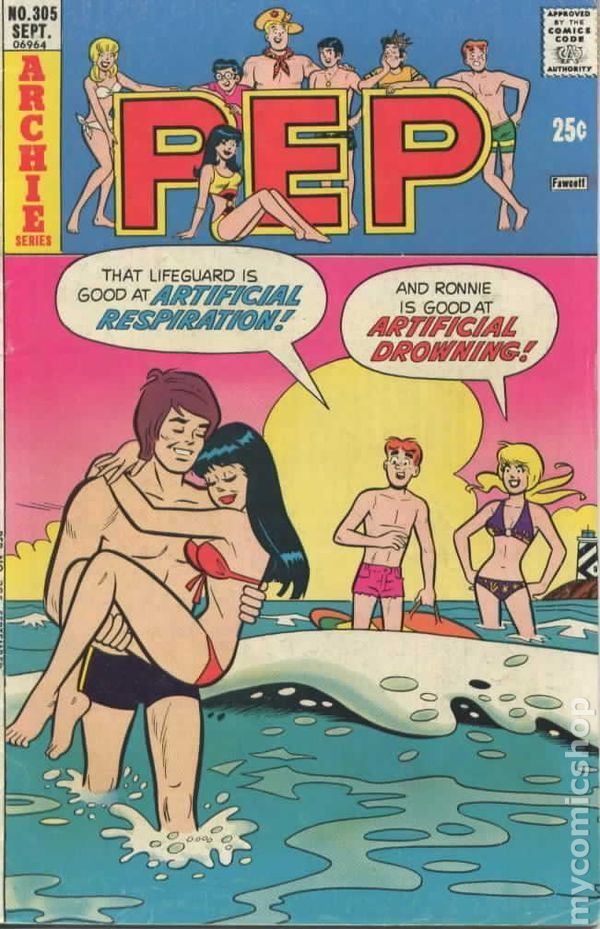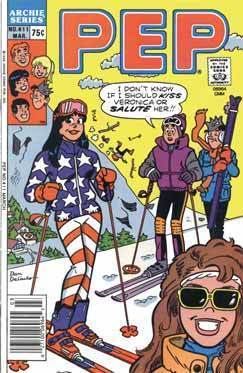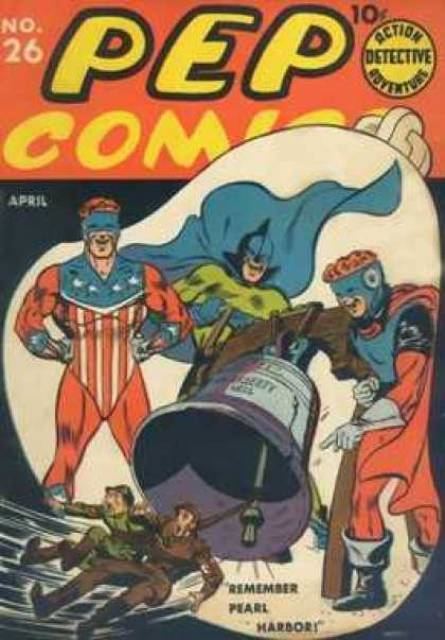Number of issues 56 | ||
 | ||
Schedule originally monthly, varied Publication date #1 (Jan 1940) - #56 (Mar 1946) Main character(s) The ShieldThe CometSergeant BoyleFu Chang, International DetectiveBentley of Scotland YardPerry Chase, The Press GuardianLee Sampson, MidshipmanKayo WardDanny in WonderlandThe FireballMadame SatanThe HangmanArchieCaptain Commando and the Boy SoldiersBlack Hood Similar Everything's Archie, Laugh Comics, Betty and Veronica, Jughead, Life with Archie | ||
Pep Comics is the name of an American comic book anthology series published by the Archie Comics predecessor MLJ Magazines Inc. (commonly known as MLJ Comics) during the 1930s and 1940s period known as the Golden Age of Comic Books. The title continued under the Archie Comics imprint for a total of 411 issues until March 1987.
Contents
- Archie pep comics 26 veronica makes the scene
- Pep Comics MLJ 19401945
- Featured series Pep Comics MLJ
- Pep Comics Archie 1945 1987
- Featured series Pep Comics Archie
- Reprints
- References

Pep Comics was the comics title that introduced the superhero character The Shield, the first of the super-patriotic heroes with a costume based on a national flag (pre-dating Captain America by over a year), The Comet, who was the first superhero to die, and Archie Andrews, who eventually became the main focus of the company's extensive range of publications.

Archie pep comics 26 veronica makes the scene
Pep Comics (MLJ) (1940–1945)

Pep Comics was the third anthology comic published by MLJ Magazines Inc., the precursor to what would become the publisher Archie Comics. The series was edited by Abner Sundell until issues #22–23 after which Harry Shorten took the reins until issue #65 (Jan. 1948). The first issue was launched in January 1940, following Blue Ribbon Comics (Nov. 1939) and Top-Notch Comics (Dec. 1939). The format of Pep Comics was very similar to the previous titles; 64 pages of short strips, initially featuring a mixture of science-fiction stories such as "The Queen of Diamonds" (#1–12) by Lin Streeter (renamed "The Rocket and the Queen of Diamonds" in #2 (Feb. 1940)), about a John Carter of Mars-like hero trapped on another planet; the crime fighting story "The Press Guardian" (#1–11) by Jack Binder and Mort Meskin and later Abner Sundell and Meskin (retitled "Perry Chase, The Press Guardian" from #7); and three adventure tales, "Sergeant Boyle" by George Biro, about a soldier fighting with the British in Europe as the U.S.A. was not yet involved in World War II, "The Midshipman", (#1–16) "Lee Sampson, Midshipman" from #6 (July 1940), following Lee Sampson through Navy College to his Graduation, and an adventure based on boxing, "Kayo Ward" (#1–28) by Phil Sturm. The last was similar to "The St Louis Kid" in Top-Notch Comics, both characters progressing through the boxing championships hierarchy throughout their series. Two short humor strips also featured in the first issue, "Jocko" and "Animal Antics", both by Dick Ryan, while "Buttonhead" by Quincy appeared in #2–5.

Pep Comics also starred superheroes and costumed characters, led by cover star and lead feature "The Shield – G-Man Extraordinary" by Harry Shorten and Irv Novick, a character who would remain in the title throughout the MLJ imprint and beyond. The Shield was mainly notable for being the first of the 'patriotically themed superheroes' who wore costumes based on the U.S. flag, 15 months before Captain America was introduced in Captain America #1 (March 1941). "The Comet" by Jack Cole ran for the first 17 issues alongside The Shield. The Shield and later The Hangman and Black Hood also featured in single page text stories during the MLJ years of the title; all comic books did this through the early 1960s to satisfy U.S. Postal Service requirements for magazine rates. The Shield also headed Pep Comics readers club from #15 (May 1941) when the 'Shield G-Man Club' was introduced to the inside front cover of every issue until The Shield finished in #65 (Jan. 1948). Although later to advertise other MLJ titles, during the war years each 'bulletin' was largely filled with patriotic messages, details of local fan-clubs and new members information, all written as if a personal message from The Shield and his sidekick Dusty.

One unusual character who featured in early issues was "Fu Chang, International Detective", whose weird detective adventure stories were in issues #1–11. Written by Joe Blair, with art by Jim Streeter, Fu Chang is a 'Chinese scholar and detective, heir to the magic secrets of Aladdin who uses them only to bring peace and good-will to the people of his Chinatown' in stories liberally sprinkled with cod-Oriental talk, evil dragon criminals, and an aura of mysticism. Another was "Bentley of Scotland Yard", a mystery detective story originally by artist Sam Cooper and later Paul Reinman. Each story was in a horror/fantasy vein, with Bentley up against creatures such as a werewolf in #1, a monster in a lake in #2, and hunchbacks, devils and vampires through the first 41 issues of Pep Comics. These would always turn out to be hoaxes, usually perpetrated to cover up a murder or for money or other gain. Each story ended with the same theme: a 'Bentley knows who ...' panel at the end of the penultimate page listing the suspects and inviting the reader to guess who committed the crime, followed by the revealing of the killer and the modus operandi on the final page.
With issue #11 (Jan. 1941), "Fu Chang, International Detective", "Perry Chase, The Press Guardian" and "The Rocket and the Queen of Diamonds" ended. To replace them, issue #12 (Feb. 1941) introduced two new characters. "Danny in Wonderland", a surreal fairy-tale adventure by Harry Shorten and Lin Streeter with stories loosely based on fairy tales such as "Cinderella", "Pinocchio", and The "Little Mermaid" (#12–39), while Ted Tyler, "The Fireball" (#12–20), 'sworn enemy of all who use fire for evil purposes' was a fireman who gained flame powers from a mixture of chemicals while fighting an arson attack. "Lucky Larson", a test pilot, filled the third place (#13–15). Further major changes came with the next two issues. "Lee Sampson, Midshipman" ended in #16 (June 1941); and Madame Satan was introduced in the same issue. Madame Satan, a dead villainess with a green face and the kiss of death, 'the scourge of man, ready to go forth and leave a trail of misery and suffering in her wake' actually first appeared on the cover of the previous issue #15 (May 1941). She was written by Abner Sundell and initially drawn by Harry Lucey, although Joe Blair wrote her later adventures.
Next a superhero died for the first time in comics history, issue #17 (July 1941). "The Comet" series ended with him being shot by gangsters while rescuing his brother in the first tale of "The Hangman" by Cliff Campbell. Hangman took The Comet's place in Pep Comics from that issue, and also featured on every cover from #17 to #42. Issue #17 also saw "Kayo Ward" become a hobo after being terribly disfigured by a fire in the church he is getting married in.
Madame Satan ended in issue #21 (Nov. 1941), her place taken in #22 (Dec. 1941) by the first appearance of one of the biggest-selling comics characters of the 20th century, Archie Andrews, and what would become the core of his friends Jughead and Betty Cooper, whose family has just moved into the neighbourhood, written by Vic Bloome and drawn by Bob Montana. Over the next few years humor strips would slowly ease the costumed heroes and adventure tales out of Pep Comics, and Archie would become Pep Comics's and the Archie Comics imprint's most popular character; but for the time being, Archie was a six-page strip that was not even mentioned on the cover.
Issue #26 (April 1942) had a 'Remember Pearl Harbor' cover, with The Shield, Dusty and The Hangman ringing the Liberty Bell while a Japanese and a German soldier were tied up in the bell-rope. The patriotism of The Shield G-Man Club was added to by the introduction of The Young Soldiers of America Club in #30 (Aug. 1942), to which membership was gained by buying war savings stamps and sending in a pledge form printed in Pep Comics. Each month, Pep Comics printed lists of readers who had done so. Continuing the war emphasis, "Captain Commando and the Boy Soldiers" also began in #30, following a teaser advertisement in #29 (July 1942). On a lighter note, issue #31 (Sept. 1942) had "Sergeant Boyle" visiting the MLJ offices after he had failed to send them details of his latest exploits for them to publish, while #34 (Nov. 1942) contained a one-page text piece, 'Meet the Editor', about Harry Shorten. Artist Gil Kane's first work was on the "Bentley of Scotland Yard" story 'The Case of the Laughing Corpse' in Pep Comics #38 (April 1943)
A new emphasis on humor grew from issue #40 (July 1943), just after Pep Comics went to 10 issues a year. "Sergeant Boyle" ended in #39 (June 1943), as did "Danny in Wonderland". They were replaced by a Li'l Abner parody, "Catfish Joe" (#40-48) and "Li'l Chief Bugaboo" (#40–47); "Bentley of Scotland Yard" ended in #41 (August 1943), replaced by the slapstick voyages of "Marco Loco, Adventurer" (#42–52) by Carl Hubbell. Even The Shield was presented with two offbeat humor stories in #41–42 as he dealt with the chaotic antics of an alien, 'Monstro the Martian', although his stories did return to their darker side after that. This humor was also reflected on the covers, as from #41 The Shield shared the spotlight with Archie Andrews, appearing mainly as a background stooge for Archie's japes. The Hangman ended in #47 (March 1944), and although he was replaced by another costumed character, Black Hood in #48 (April 1944), the humor continued to take over. The Shield last appeared on a cover with #50 (September 1944), after which Archie featured on every cover until the end of the series in 1987. The publishing frequency dropped to quarterly between 1944 and 1946. Issue #52 (March 1945), saw the arrival of Harry Sahle's dizzy blond "Suzie", who could never keep a job long.
Archie's rise in popularity continued, and Pep Comics was used to further this. Issue #42s 'G-Man Club' page (Sept.1943) was all about Archie having a regular radio spot on the National Broadcasting System, and the cover announced in a large banner across the page 'Archie Talks – Tune in Your Radio over the Blue Network' while depicting The Shield and Hangman in blue shadows watching Archie recording in the studio. By #49 (March 1945), the first 52-page issue, the cover was bannered 'Starring Archie Andrews' and he became the lead story from then on. Except for appearances in #59 and #60 (both from 1946), the recently introduced Black Hood disappeared after issue #51 (Dec. 1944), leaving only The Shield as a non-humor story. Issue #53 (June 1955) began a family strip "The Twiddles" by Bill Woggon, "Pokey Oakey" (#53–55) who had previously been in Top-Notch Comics and "Willie the Wise-Guy" by Red Holmdale. By #56 (March 1946) the cover sported the legend 'An Archie magazine' and for the first time there was no MLJ triangle; in the following issue, #57 (June 1946), the indicia read 'Archie Comics Publications Inc', and the MLJ era of Pep Comics was over.
Featured series: Pep Comics (MLJ)
Pep Comics (Archie) (1945 - 1987)
With the change of Pep Comics statement of ownership from MLJ to Archie Publications Inc. from issue #57 (June 1946), the transfer from adventure and humor titles accelerated on a publication frequency that varied from 5 issues a year in 1947 to bi-monthly the following year. Top-Notch Comics ongoing series "Dotty and Ditto" had transferred to Pep Comics with issue #57 (June 1966), although it ended in #58 (with a guest appearance in Dotty's dreams by the Shield, Archie and Suzie). New long-running series began, "Gloomy Gus the Homeless Ghost" in #59 (Dec. 1946), Bill Woggon's "Katy Keene The Pin-Up Queen" a model whose stories were filled with costumes designed by readers (who were given namechecks in the issue their designs appeared in) replaced "Suzie", and Li'l Jinx arrived in #62 (July 1947), replacing Black Hood—who had made two final appearances in #59–60 and revealed his identity to the world, becoming a detective. All these humor strips would continue in Pep Comics for years, Katy Keene running until #154, although Bill Woggon had stopped drawing her with #126, and Li'l Jinx staying to the end.
"The Original Shield and Dusty the Boy Detective" finally ended their run in Pep Comics in #65 (January 1948), after two reprint stories in the last two issues, after which Pep Comics became an all-humor title. The "G-Man Club" became "The Archie Club" the next issue.
Published details of sales of Pep Comics in the 1960s from the 'Statement of Circulation' show that average sales of the title were between 269,504 in 1960 and 292,572 in 1969. During the 1970s this dropped to between 231,963 and 100,827, although publication frequency crept up to nine times a year by 1964, after which Pep Comics returned to monthly publication.
Issues #218 (June 1968) and #227 (March 1969) featured Archie and his friends as pop band 'The Archies' on the covers, a fictional band which was later put together for real, also as The Archies.
There was a minor revival in superhero characters between #150 (Oct. 1961) and #160 (Jan. 1963), when Archie Comics included a short run of stories featuring their recent superheroes The Fly, Flygirl and The Jaguar in loose rotation, plus one extra Jaguar story in #168 (January 1964). In addition, issue #393 (Mar. 1984) contained an appearance by Martin Greim's funny animal character Thunderbunny, when Archie Comics briefly licensed the character.
Pep Comics published its 200th issue in October 1966, its 300th in April 1975, and its 400th in May 1985—an issue which included cameos of all the Archie Comics staff. However, by then sales had slipped from their previous levels to 55,164. The series lasted until #411 (Mar 1987). A number of the "Archie Giant Series Magazines" in the late 1980s and early 1990s carried the Pep Comics name, but it has not been revived since. However, in August 2009 Michael Uslan announced that five one-shot comics reviving the Archie-as-superhero 'Pureheart' concept would be released in 2010, one of those titles being Pep Comics. A special one-shot 'Pep Comics featuring Betty and Veronica' was published for the May 2011 Free Comic Book Day.
